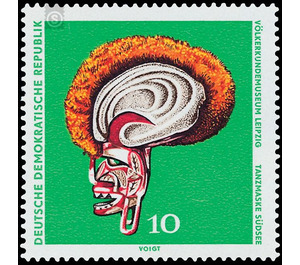Museum of Ethnology, Leipzig: Exhibits - Germany / German Democratic Republic 1971 - 10 Pfennig
Theme: Architecture
| Country | Germany / German Democratic Republic |
| Issue Date | 1971 |
| Face Value | 10.00 |
| Color | green |
| Perforation | K 13 |
| Printing Type | Photogravure |
| Stamp Type | Postage stamp |
| Item Type | Stamp |
| Chronological Issue Number | 1374 |
| Chronological Chapter | GER-DDR |
| SID | 710168 |
| In 37 Wishlists | |
From the Museum of Ethnology in Leipzig The Ministry of Posts and Telecommunications of the German Democratic Republic publishes four multicolored special postage stamps depicting exhibits from the Museum of Ethnology in Leipzig. Ethnography The originals of the motives of this issue are in the Museum of Ethnology of Leipzig, the largest ethnographic museum on the soil of the German Democratic Republic, whose 100th anniversary roughly coincides with the appearance of this series. The brand motifs represent the four non-European continents represented in the museum's exhibitions: Australia / Oceania, Africa, Asia and America. It is probably no coincidence that three of the four depicted motifs depict ancestral-cult objects, a world-view prevalent over a long period of social evolution, and consequently happiness and unhappiness, both of the individual and of the human community and its institutions depend on the action of the spirits of deceased ancestors. The ancestral cult objects have always been carefully crafted and preciously decorated; however, according to the different levels of material culture and technical skills of their manufacturers, they are different in shape and material. The 10 Pfennig value shows a dance mask, which was created in the second half of the 19th century and originates from Northern New Ireland (Bismarck Archipelago, Oceania). Such masks were worn during dances on the occasion of the funeral; their bearers became the embodiment of mythologized ancestors. The comb of fibers running overhead in the middle of the mask points to an old hairstyle in which the head was shaved and otherwise adorned. This was suggested in the mask by a different design of the two sides (the visible on the mask side is provided with a thick Kalkauflage in which patterns are notched, the other side is completely covered with Pflanzenmarkstäbchen). The face part is carved from soft wood and painted white, red and black, as eyes are used cut lids of a Schneckenart; the headboard consists inside sewn together parts of the outer coconut shell. Dimensions: height 43.5 cm, width 25 cm, depth 38 cm.


